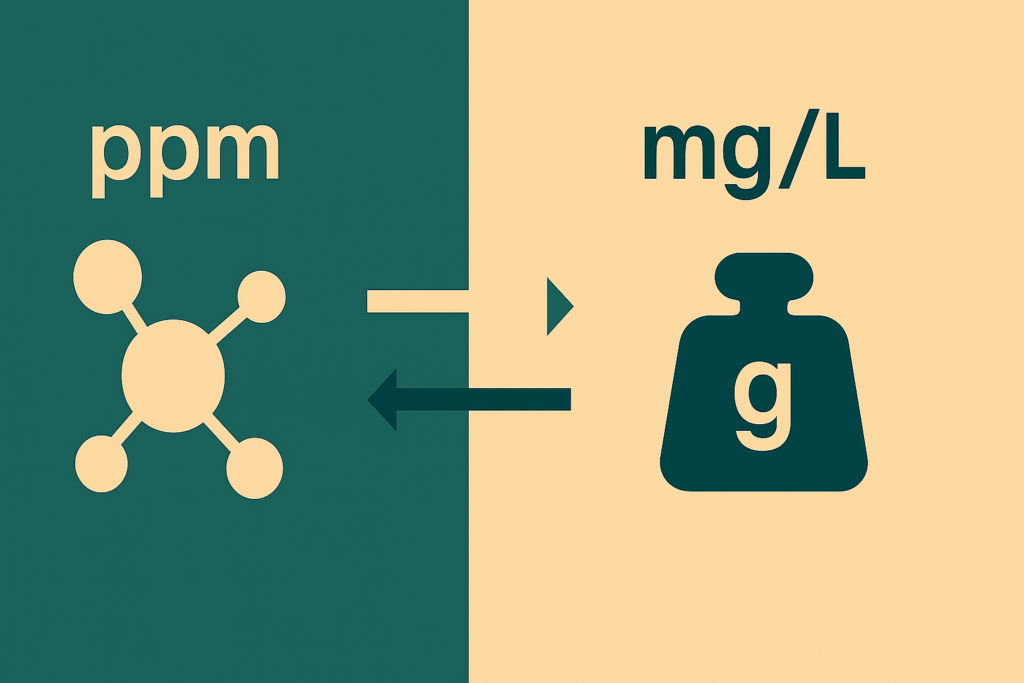In the world of science, chemistry, and environmental monitoring, ppm (parts per million) and mg/L (milligrams per liter) are two of the most frequently used units to express concentration. They often appear in lab reports, water quality assessments, agricultural tests, and industrial compliance documentation. While they seem interchangeable in many contexts, understanding the subtle differences—and when they matter—is crucial to avoid costly mistakes.
This article will clearly define each unit, explain when they are equal, highlight situations where they differ, and show you how to avoid common misinterpretations with a simple cheat-sheet at the end.

Easily convert Parts Per Million (PPM) to Milligrams per Liter (mg/L), Micrograms per Cubic Meter (µg/m³), and Grams per Liter (g/L) with our free online tool. Fast, accurate, mobile-friendly—get instant results now.
Definitions: What Are ppm and mg/L?
Let’s begin with what each unit really means:
- ppm (parts per million) is a ratio-based unit. It represents the number of parts of a substance per one million parts of the total mixture. It’s dimensionless and commonly used to express trace concentrations—like the amount of chlorine in water or CO₂ in the atmosphere.
- mg/L (milligrams per liter) is a mass-to-volume unit. It measures how many milligrams of a substance are present in one liter of solution. Unlike ppm, it has units and depends on the volume and density of the liquid.
Despite these differences, in many common scenarios—such as water testing—these units can often be used interchangeably. But not always.
When They’re Equivalent: Dilute Aqueous Solutions
In dilute water-based solutions, especially under normal room temperature and pressure, 1 ppm = 1 mg/L.
Here’s why:
- The density of pure water is approximately 1 g/mL, or 1000 g/L, which equals 1,000,000 mg/L.
- So, 1 mg of solute in 1 liter of water corresponds to 1 part in 1 million.
Example:
If you add 10 mg of sodium to 1 liter of water, the concentration is:
- 10 mg/L
- Which is approximately 10 ppm
This equivalence holds true as long as:
- The solvent is pure water
- The solution is dilute
- The density remains close to 1 g/mL
When They Differ: Non-Water Solvents and Density Factors
The 1:1 ppm = mg/L relationship breaks down in more complex conditions:
1. Non-Aqueous Solutions
In solvents like ethanol, oil, or glycerin, the density is not 1 g/mL. This means mg/L and ppm no longer match directly.
2. Highly Concentrated Solutions
As solute concentration increases, the density of the solution may change significantly, disrupting the 1:1 ratio.
3. Temperature and Pressure Variations
Since the density of most liquids (even water) varies with temperature and pressure, extreme conditions can make ppm ≠ mg/L.
Formula for Precision:
ppm=mg/Ldensity in g/mL\text{ppm} = \frac{\text{mg/L}}{\text{density in g/mL}}ppm=density in g/mLmg/L
Example:
You have a solution in ethanol, with a density of 0.789 g/mL:
- 100 mg/L = 100 / 0.789 ≈ 126.7 ppm
In this case, assuming 1 mg/L = 1 ppm would underestimate the concentration by over 25%.
Industry Implications: Why It Matters
1. Laboratories
Precise unit conversion is crucial in chemical analysis. A small mistake in unit interpretation can throw off results, affect reactions, or fail compliance audits.
2. Environmental Monitoring
When monitoring pollutants like nitrates, heavy metals, or pesticides, reporting in the wrong units can lead to false safety claims or regulation violations.
3. Water Treatment
Operators frequently use ppm and mg/L to dose chemicals or monitor contaminants. Misunderstanding the difference can lead to overdosing or underdosing, impacting health or system performance.
4. Agriculture
Farmers rely on accurate ppm/mg/L data when managing nutrient solutions in hydroponics or irrigation systems. Errors can stunt plant growth or burn roots.
Common Misinterpretations to Avoid
Here are real-world mistakes professionals and students often make:
- Assuming ppm = mg/L in non-water solutions
→ Always check the solvent and density. - Using ppm as a mass-based unit
→ Remember, ppm is a ratio, not a mass/volume unit. - Ignoring temperature impact on density
→ Density tables or online calculators can help. - Applying ppm = mg/L in gas measurements
→ In air, ppm usually refers to volume ratio, and mg/L refers to mass per volume—they are not equivalent without conversion based on molar mass and temperature.
Quick Cheat-Sheet: ppm vs mg/L
| Situation | ppm = mg/L? | Action to Take |
| Dilute water solution (25°C) | ✅ Yes | Use 1:1 conversion |
| Ethanol or oil-based solvent | ❌ No | Adjust for density |
| High solute concentration | ❌ No | Check solution density |
| Air or gas measurements | ❌ No | Use gas laws to convert |
| Temperature-controlled labs | ⚠️ Maybe | Verify density from tables or tools |
| Environmental water testing | ✅ Usually | 1:1 is acceptable unless heavily polluted |
Final Thoughts
Understanding the difference between ppm and mg/L is more than just academic—it’s critical in real-world applications across science, health, and industry. While these two units often align in water-based systems, making that assumption across the board can lead to serious miscalculations.
When in doubt, consider the density of your solution, the temperature conditions, and the context (air, water, or another liquid). Use trusted online converters when precision is key, and always double-check your assumptions.
With this knowledge—and our handy cheat-sheet—you’ll be well-equipped to handle ppm and mg/L with accuracy and confidence.

